Elevate the power of your work
Get a FREE consultation today!
Product teams must consider the impact of their design decisions for the good of their customers and our environment. An agile, customer-focused methodology incorporating circular economy concepts can help.

If you recycle, you’re living your belief that using and regenerating products or components in environmentally friendly ways is good for our planet and its people. By extension, you’ll likely find value in the circular economy concept. According to the renowned Ellen MacArthur Foundation, “Through design, we can eliminate waste and pollution, circulate products and materials, and regenerate nature, creating an economy that benefits people, business, and the natural world.”
The question: Are your product teams prepared to implement circular economy practices?
As a child, I played nearby while my parents tugged thousands of rusty nails from used lumber they’d salvaged from a weathered gray warehouse 75 miles away. That lumber formed the walls of the first home that belonged to us. We kept our garden busy year-round, rotating crops to replenish the soil. We canned, froze, and dried our produce because the closest grocery store was 25 hard miles and one-fourth of a tank of gas away. From peelings, stalks, and cuttings, we fed our pets. This was our circular economy, where we reused and repurposed everything until we used it up.Now, with 94% of organizations integrating environmental, sustainability, and governance goals into their strategy, CIOs, operations teams, and solutions engineers are under mounting pressure to produce results. One way to transform operations and deliverables is to consider circular economy practices when designing offerings. Unfortunately, many in design and development roles lack formal training in these practices and need help integrating them into their offerings while delivering against shrinking deadlines.
The good news: An agile, four-phase innovation methodology can jump-start sustainable development by helping teams ask the right questions at each phase. With the underlying concepts in mind, teams can begin creating more sustainable products.
To do this, teams must emphasize the “cycle”–starting with a traditional life cycle like the one shown but with sustainability at its core. Every team and team member involved in the product life cycle must consider multiple variables, factoring in the environmental and human impact of the offerings they’re developing and putting into the market.
Get a FREE consultation today!
The Innovation team at Iron Mountain uses a four-phase customer-focused methodology called Compassion-Driven Innovation.
In this paper–How to Accelerate Sustainability & Inclusion through a Rapid Innovation Methodology– we’ve augmented that methodology by adding critical sustainability concepts and sharing our approach to integrating sustainability into innovation practices.
We’ve outlined the four phases of innovation: Include, Discover, Enlighten, and Activate and included foundational information about emissions and circular economy concepts. We’ve also integrated questions about sustainability and related considerations regarding a product’s impact on society.
For example, in the Include phase, teams might ask questions such as:

Using this approach, product design and development teams can have exploratory discussions with internal environmental, sustainability, and governance (ESG) experts and external customers to better understand a product’s potential impact. With this information, they can design offerings that benefit us all.
My family had no words for what we did while living in our circular economy. It was simply a way of life passed through generations. We minimized our environmental footprint while reusing and recycling what might have been waste, minimizing pollution, and regenerating the soil. We thrived from it. That house built from those weathered boards still stands more than a half-century later, covered in rosy shingles just as my mom imagined–inviting us to gather and remember the warmth and joy we’ve shared inside. Someone else’s trash became our refuge.
No matter how small or insignificant, everyone’s efforts matter. Anyone who recycles, reuses, and repurposes materials contributes to sustainability and, to varying degrees, the circular economy.
A wealth of information exists on the circular economy concept, particularly from The Ellen MacArthur Foundation website. For more information about achieving your organization’s sustainability goals, see Rethink Sustainability.


